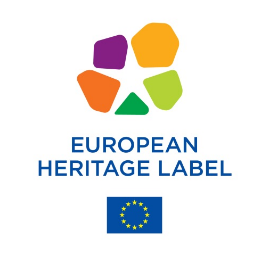European Heritage Label
In 2016, the Imperial Palace Vienna was awarded the European Heritage Label (EHL), which is granted to European sites of historic significance.

Today, the Imperial Palace Vienna, which once served as the residence of the Habsburg family, houses the offices of the Austrian Federal President. Throughout its 700 years of history, it has shaped Europe’s political, economic and military fate like no other.
Due to the active role of Burghauptmannschaft Österreich among the award-winning sites, they are now also coordinator of the EHL@N(etwork) since 2019. An initiative, that provides all existing and future heritage label holders with valuable experience and tools to support them in fulfilling their tasks as representatives of cultural heritage. An initiative that provides all existing and future cultural heritage seal holders with valuable experience and tools to support them in fulfilling their tasks as cultural heritage sponsors.
Ever since its creation around 1240 the building complex of the Imperial Palace Vienna has played a considerable role in both European and Austrian history. Its significance is due to its role as a constant seat of governments and emperors as well as to it being the target of failed Ottoman expansion, point of depart of the counter-reformation, the target of Napoleon’s multilateral policy and the place where Europe’s frontiers would be redefined after the Congress of Vienna (1814–1815). Not to mention that it was situated in the multi-ethnical capital of the multireligious empire which – as such – anticipated many of the goals and ambitions of the European Union.
As testified by the numerous conferences and congresses as well as the meetings of European and international politicians held in the Imperial Palace Vienna, the Palace has not ceased to be a centre of action, where Europe has been shaped and further developed even after the end of the Austro-Hungarian Monarchy.
Throughout a period of 1000 years, the Habsburg residence in Vienna was transformed into one of the most incredible exhibition centres worldwide: 16 museums, three churches, one of the most important libraries in the world, one congress centre for international meetings and ceremonial halls where balls take place testify to the democratic reinterpretation of the former imperial government district. This is also expressed by the fact that the president of the Republic of Austria has his offices there. Counting 18 wings, 54 stairs, 19 courtyards and 2600 rooms and halls, the Palace area is one of the world’s largest mundane residence districts. In combination with the museum quarter (MuseumsQuartier), the Palace area stretches more than 500,000 square metres. It, therefore, is one of the biggest cultural sites.
European Heritage Label Network
In 2013 the EU Commission started the European Heritage Label (EHL) as an initiative of several national governments to improve the knowledge of European history and the role and values of the EU. The purpose of the European Heritage Label (EHL) is to emphasis a common European history, to strengthen the feeling of belonging to the Union among all European citizens, turning previous borders into bridges. In addition, taking advantage of the diversity that characterizes European culture, to stimulate intercultural dialogue and to still create a sense of being part of a united Europe.
The main goal of the EHL@N project is therefore to give (higher) visibility and reinforce the idea of
- a common European culture: rich, flourishing, diverse; built on and through a long shared history,
- a shared heritage which helps to define common values and eventually a shared identity for European citizens,
- the integration of those values defining the European Union project and making them attractive for all, especially for young people.
- finally, supporting quality and sustainable growth through capacity building measures and audience development, combining the enhancement of cultural heritage with the encouragement of contemporary creation and creativity.
In order to achieve those goals as well as to fulfil the mission that the EHL sites have defined for their cooperation, the network shall accomplish the following objectives:
- to develop an appropriate framework/network structure, establish mission statement and ensure sustainability
- to strengthen the existing brand EHL using common CD and utilise the label brand
- to develop and maintain an engaging multilingual website for the general public
- to disseminate, communicate and market the network project as well as the network – by creating and initiating models, tools and means to improve the visibility of each site and the future of the entire network
- develop and maintain a support website for EHL network and sites, containing information about cooperation, education, exchange programmes and joint activities as well as funding opportunities
- to strengthen co-operation between EHL sites, through common conferences and events, exchange of best practice, project ideas and training offers
- to support sites in order to meet the requirements of monitoring procedure of EU Commission
- to identify and promote the key values common to the EHL sites as well as Europe as a whole
- to support EHL sites in developing individual and/or joint project ideas
With EHL@N sites can rely on a strong support system, offering quality information, practical tools and means as well as useful services for prosperity and long-term success, which is going to benefit all of Europe.
Involved partners:
- Burghauptmannschaft Österreich
- Archaeological Park Lower Austria Ldt. - Römerstadt Carnuntum
- Hambach Castle Foundation
- City of Osnabrueck
- City of Muenster
- City of Lublin
- Olomouc Art Museum
- Fondazione Museo Storico Del Trentino
- Liszt Ferenc Academy of Music
- University of Tartu
- Fundación Residencia de Estudiantes
- Budapest Jewish Community
- Archiwum Główne Akt Dawnych
- Direção-Geral do Livro, dos Arquivos e das Bibliotecas
- Fondazione Trentina Alcide de Gasperi
- Civica Academy Foundation
- Direção Regional de Cultura do Algarve
- Municipality Tolmin
- Verbund der Gedenkstätten im ehemaligen KZ-Komplex Natzweiler e.V.
Find more information about the partners
All further information can be found on the EU page European Heritage Label Sites.